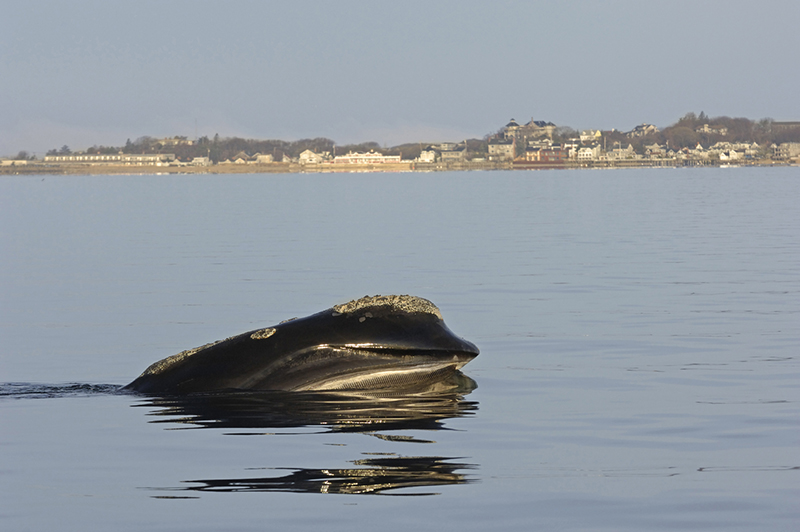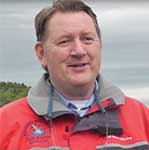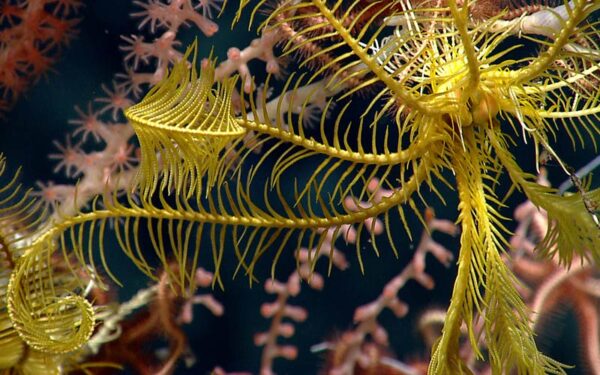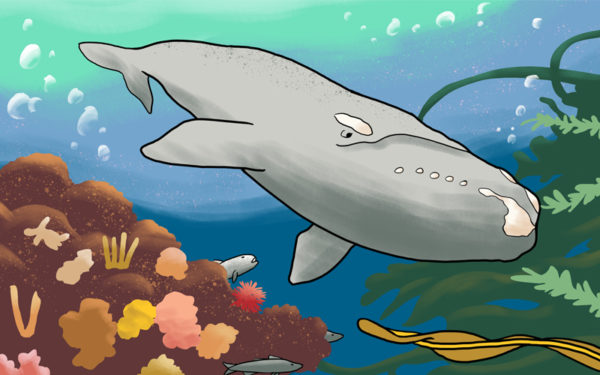
With barely 500 North Atlantic right whales left on the planet, they face threats from warming waters, which push their food sources north, as well as fishing net entanglements and ship collisions.
Saving North Atlantic Right Whales from Extinction
Listening to Zack Klyver describe North Atlantic right whales, it’s clear how much the veteran naturalist holds them in awe. “They are magnificent,” he says. “They’re over a hundred thousand pounds and 50 to 60 feet long, with an enormous black tail that’s very symmetrical and beautiful when they bring it up out of the water. They are just amazing animals to see.”
Seeing a right whale, however, is increasingly rare. Klyver has guided whale watching trips for more than 25 years, currently as head naturalist for the Bar Harbor Whale Watch company. Tour boats, he says, spot right whales only a couple of times in a season.

The story of this rare whale is a sadly familiar one. Historically, they were targeted by whalers because they were commercially lucrative and easy to kill. Today, with barely 500 North Atlantic right whales left on the planet, they face threats from warming waters, which push their food sources north, as well as fishing net entanglements and ship collisions. “The East coast between the Gulf of Maine and Florida is really an urban environment,” Klyver says, noting that 82 percent of surviving whales today have scars from entanglements with nets or ship strikes.
If the Trump administration moves forward with plans to aggressively search for oil and gas resources in the Atlantic, then the Eastern corridor along which the whales migrate could get even more dangerous. The seismic testing required to find those oil and gas reserves can disrupt whales’ mating and feeding, cause hearing loss, and even lead to death.
And if those challenges weren’t enough, the population has suffered a major setback this summer: seven right whales were found dead in Canada’s Gulf of St. Lawrence. While the cause of the deaths is not yet known, losing even one whale is a tragedy. Seven is catastrophic. [Update: As of October 24, 2017, NOAA Fisheries lists 16 confirmed right whale deaths this year, officially declaring an “Unusual Mortality Event.”]
These are significant headwinds to overcome if the species is ever to recover. That’s why CLF, which has long been a champion for the North Atlantic right whale, is redoubling its efforts to help safeguard whales from New England’s increasingly “urban” waters.
One such effort is using accurate, accessible data from the Northeast Ocean Portal, part of the implementation of the landmark Northeast Ocean Plan. Knowing the locations of whale migration corridors, for example, can help avoid potentially deadly conflicts, say by moving a shipping lane a quarter mile east or west.
Also, with more and larger offshore wind farms now planned for the waters off of Massachusetts, CLF will be actively working with developers to ensure that New England’s transition to a clean energy economy doesn’t come at the expense of the area’s most fragile marine wildlife. The organization and its partners made history in 2014 when they reached an agreement with Deepwater Wind to protect whales from harm during wind farm site assessment and construction activities. CLF will build off of that success and work towards similar agreements for new wind projects planned for the region.
In addition to these efforts, Klyver cites the need for protected areas, including the Gulf of Maine’s Cashes Ledge, an area that CLF is fighting to protect permanently. In 2012, Klyver was with New England Aquarium researchers when they discovered that Cashes Ledge is a winter breeding ground for the imperiled species. “We saw 35 whales in one day and finished at sunset with right whales breeching all around us,” he says. While breeding grounds can range over hundreds of square miles, “Cashes Ledge is critically important,” Klyver says, making CLF’s ongoing efforts to protect the area even more urgent and necessary. “Having a protected area for wildlife and whales in the Gulf of Maine would be a wonderful thing.”
For Klyver, protecting North Atlantic right whales is part of being a responsible steward of New England’s ocean. Every year, as he shares his awe for whales with tens of thousands of visitors on his tour boats, he revels in their experiences. “You never forget seeing your first whale,” he says. “I just feel incredibly fortunate to be an ambassador for this environment.”



